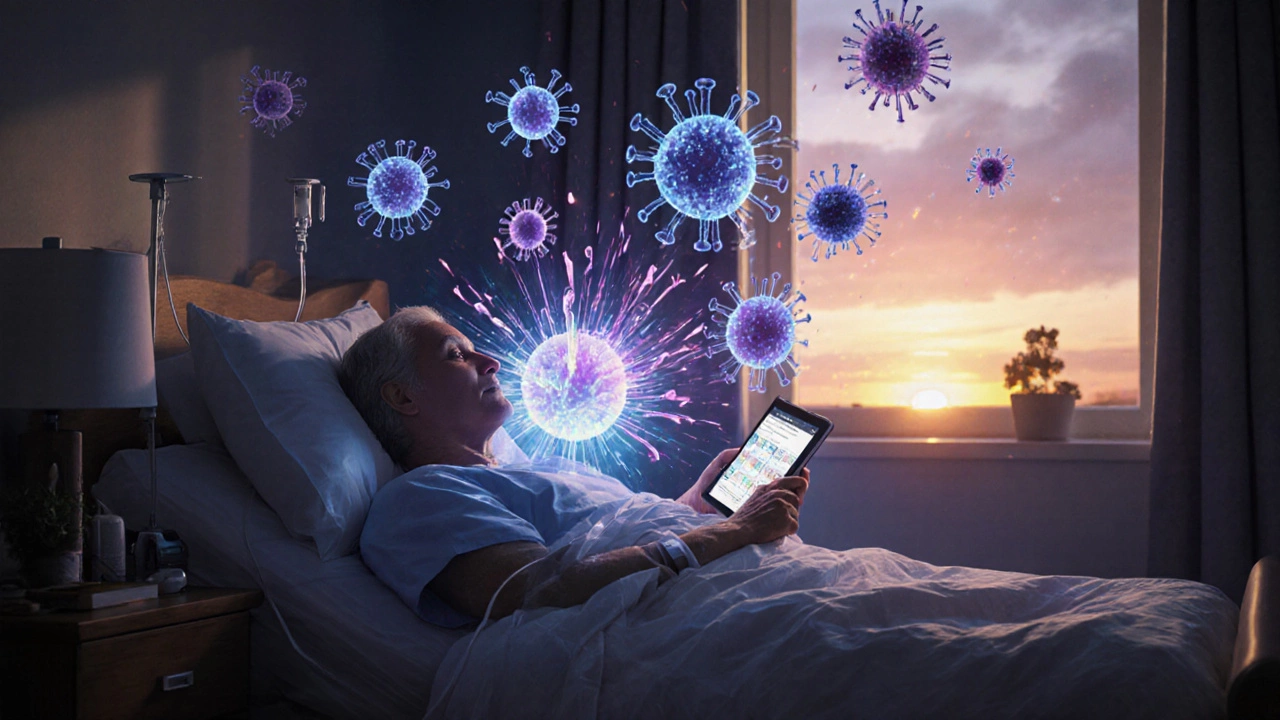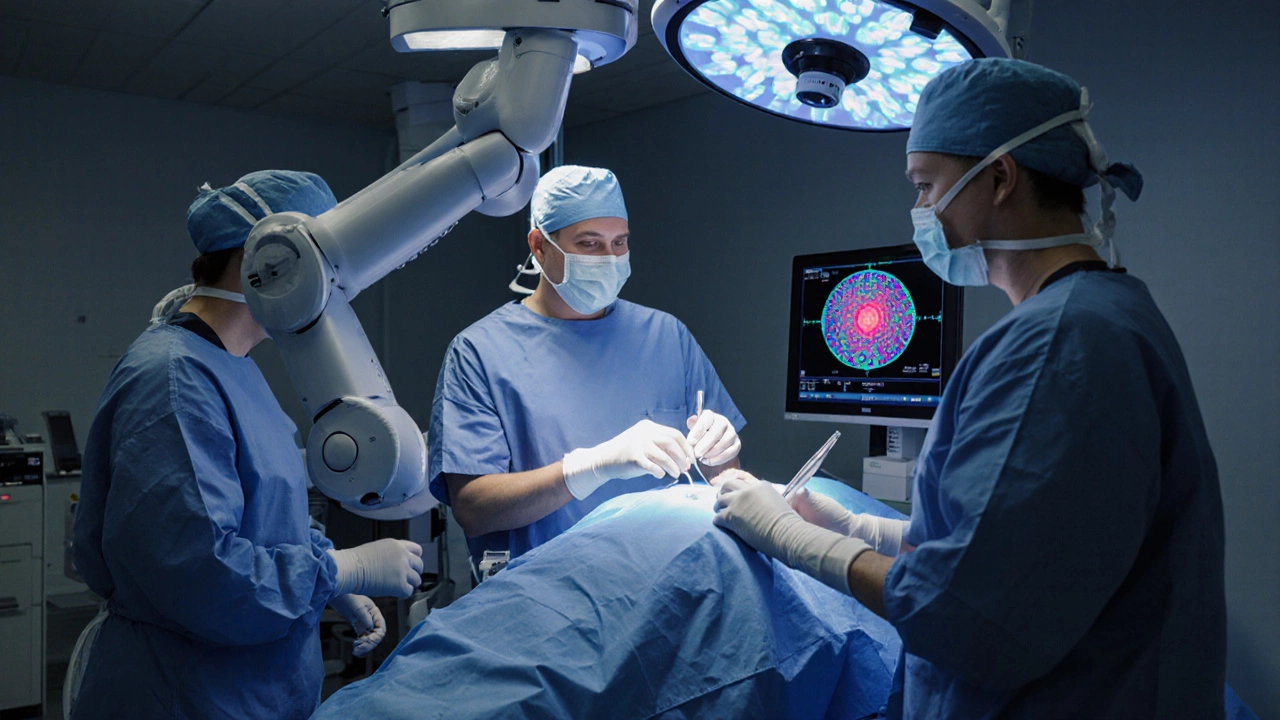Cancer Treatment Pathway Calculator
Find Your Treatment Pathway
Based on cancer type and stage, this tool shows typical treatment combinations used by oncologists. Select options below to see your personalized treatment pathway.
Your Treatment Pathway
Treatments are selected according to current medical guidelines
Why This Combination?
Oncologists combine treatments based on cancer biology, stage, and patient factors. For example, surgery often precedes other treatments to remove the primary tumor.
Access in India
All treatments are available in major Indian cities. Government hospitals offer cost-effective options, while private facilities provide advanced therapies like immunotherapy and proton therapy.
When someone hears the word cancer, fear often follows. But today, cancer isn’t a death sentence-it’s a condition that can be managed, controlled, and sometimes cured. The top five cancer treatments used worldwide have evolved dramatically over the last decade. They’re not just about killing cells anymore; they’re about precision, personalization, and protecting the body’s own defenses.
Surgery: The First Line of Defense
Surgery is still the most common starting point for many solid tumors-especially when cancer hasn’t spread. Think breast cancer, colon cancer, lung cancer, or skin melanoma. The goal? Remove the tumor and a small margin of healthy tissue around it to make sure no cancer cells are left behind.
It’s not always about cutting out large chunks. Minimally invasive techniques like laparoscopic or robotic surgery are now standard in many hospitals. These mean smaller scars, less pain, and faster recovery. In early-stage cancers, surgery alone can be enough. A 2023 study from the National Cancer Institute showed that for stage I colon cancer, surgery alone led to a 92% five-year survival rate.
But surgery isn’t right for everyone. If the cancer has spread to lymph nodes or distant organs, removing one tumor won’t fix the problem. That’s when doctors turn to other tools.
Chemotherapy: The Classic Workhorse
Chemotherapy uses drugs to kill fast-growing cells. It’s been around for decades, but it’s far from outdated. Today’s chemo is smarter, better targeted, and often combined with other treatments.
It works best for cancers that spread quickly-like leukemia, lymphoma, or testicular cancer. Chemo can shrink tumors before surgery (neoadjuvant), kill leftover cells after surgery (adjuvant), or control cancer that’s already spread (palliative).
Side effects like nausea, hair loss, and fatigue are real. But new anti-nausea drugs and growth factor injections help patients stay stronger. Some chemo drugs now come in pill form, so patients can take them at home. And in places like India, where access to advanced care varies, chemo remains one of the most widely available and cost-effective options.
Radiation Therapy: Focused Energy
Radiation therapy uses high-energy beams-X-rays, protons, or gamma rays-to destroy cancer cells. It’s often used when surgery isn’t possible, or to shrink tumors before surgery. It’s also common for cancers in sensitive areas like the brain, throat, or prostate.
Modern radiation is precise. Techniques like IMRT (intensity-modulated radiation therapy) and SBRT (stereotactic body radiotherapy) let doctors target tumors within millimeters, sparing healthy tissue. A patient with early-stage lung cancer might get five high-dose sessions instead of 30 low-dose ones. That’s fewer trips, less time off work, and better quality of life.
Proton therapy, a newer form, is especially useful for children and tumors near critical organs. It delivers radiation with less exit dose, meaning less damage to tissues beyond the tumor. While not available everywhere, it’s becoming more common in major cities like Bangalore, Delhi, and Mumbai.

Immunotherapy: Training Your Body to Fight Back
Immunotherapy is one of the biggest breakthroughs in cancer care since chemotherapy. Instead of attacking cancer directly, it helps your immune system recognize and destroy it.
Drugs like pembrolizumab (Keytruda) and nivolumab (Opdivo) block proteins that cancer uses to hide from immune cells. Once those brakes are released, T-cells can find and kill cancer cells. It’s been life-changing for melanoma, lung cancer, and kidney cancer patients-some of whom have lived years longer than expected.
Not everyone responds. Only 20-40% of patients see major benefits, depending on the cancer type. Biomarker tests (like PD-L1 levels or tumor mutational burden) help doctors predict who will respond. In India, these tests are now available in most private hospitals, though cost can still be a barrier.
Side effects are different too. Instead of nausea, patients might get rashes, thyroid issues, or inflammation in the lungs or liver. But when it works, the results can be long-lasting-even permanent.
Targeted Therapy: Hitting Cancer’s Weak Spots
Targeted therapy attacks specific molecules that drive cancer growth. Unlike chemo, which hits all fast-growing cells, targeted drugs are like smart missiles. They only affect cancer cells with certain genetic mutations.
For example, if a breast cancer patient has a HER2 mutation, drugs like trastuzumab (Herceptin) can block that signal. If lung cancer has an EGFR mutation, osimertinib (Tagrisso) can stop it from spreading. These drugs often come as pills, taken daily at home.
They’re used mostly for advanced cancers. But they’ve changed the game. A patient with stage IV lung cancer who used to have months to live might now live five years or more. The catch? Testing is required. You need a biopsy and genetic sequencing to find the right target. That’s why many hospitals now offer comprehensive genomic profiling as part of the initial workup.
Resistance can develop over time. But new generations of drugs are being developed to overcome this. In India, generic versions of many targeted drugs are now available at a fraction of the cost, making them more accessible.

How These Treatments Work Together
No single treatment works for every cancer. That’s why oncologists use combinations.
- Surgery + chemo for colon cancer
- Radiation + immunotherapy for head and neck cancer
- Targeted therapy + chemo for advanced breast cancer
The order matters. Sometimes chemo shrinks the tumor first so surgery is easier. Sometimes immunotherapy is used after radiation to boost the immune response. Personalized treatment plans are built using cancer type, stage, genetics, age, and overall health.
For example, a 58-year-old woman with stage II breast cancer and a BRCA mutation might get surgery, then targeted therapy with olaparib, followed by hormone therapy. A 45-year-old man with advanced melanoma might start with immunotherapy and avoid surgery entirely if the tumors shrink.
What’s Next?
Research is moving fast. CAR T-cell therapy-where a patient’s own immune cells are reprogrammed to hunt cancer-is now approved for certain leukemias and lymphomas. Liquid biopsies (blood tests that detect cancer DNA) are replacing invasive tissue biopsies in some cases. AI is helping predict which treatments will work best based on a patient’s tumor profile.
But the core hasn’t changed: early detection, accurate diagnosis, and the right combination of treatments still save lives. The top five treatments aren’t just tools-they’re part of a system designed to give people more time, more quality, and more hope.
Can cancer be cured without any of these five treatments?
In rare cases, yes-but only for very early-stage cancers caught by screening. Some small skin cancers or precancerous growths can be removed completely with local treatments like cryotherapy or topical creams. But for most cancers, especially those that have grown or spread, one or more of these five treatments are necessary. Relying on supplements, diets, or alternative therapies alone has not been shown to cure cancer in clinical trials.
Which treatment has the fewest side effects?
Targeted therapy and immunotherapy often cause fewer side effects than chemotherapy or radiation, but they’re not side-effect-free. Targeted drugs might cause rashes or high blood pressure. Immunotherapy can trigger autoimmune reactions. Radiation causes localized fatigue and skin irritation. Surgery carries risks of infection or complications from anesthesia. The "least harsh" option depends on the cancer type and the patient’s health. For many, the trade-off is worth it-longer survival outweighs temporary discomfort.
Are these treatments available in India?
Yes. All five treatments are available in major Indian cities like Bangalore, Delhi, Mumbai, and Chennai. Government hospitals offer chemotherapy and radiation at low cost. Private hospitals provide advanced options like immunotherapy, targeted therapy, and proton therapy. Generic versions of many drugs are now made locally, cutting costs by 60-80%. Access is still unequal in rural areas, but tele-oncology and mobile clinics are improving reach.
How do I know which treatment is right for me?
Your oncologist will use your cancer type, stage, genetic profile, age, and overall health to build a plan. You’ll likely have a biopsy, CT or PET scan, and possibly genetic testing. Don’t hesitate to ask for a second opinion. Many hospitals now have tumor boards-teams of specialists who review complex cases together. Your treatment plan should be explained clearly, with options, risks, and expected outcomes.
Can I still work during treatment?
Many people do. Chemotherapy and radiation can cause fatigue, but not everyone feels sick. Targeted therapies and immunotherapies often allow patients to keep working full-time, especially if side effects are mild. Some adjust hours, work from home, or take short breaks. Talk to your doctor about your job demands. Many employers in India are legally required to support cancer patients under disability laws.
